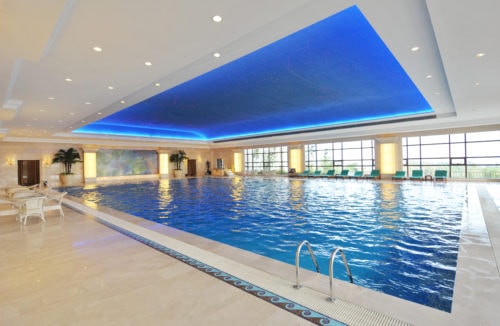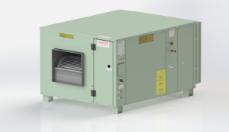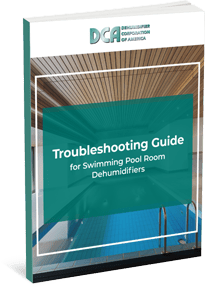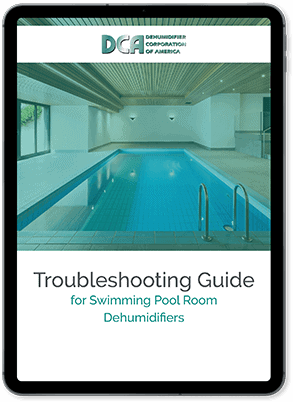The primary function of an indoor pool room dehumidification system is to preserve the integrity of the room’s structure by controlling relative humidity. Pool room natatoriums have very specific construction parameters that designers must take into consideration during a project’s planning stages. 
Pool Room Natatorium Design Considerations for Humidity Control
When any type of swimming pool, spa, or water feature is part of a natatorium project, you should consider a variety of factors. Technicians must install an integral vapor barrier, usually visqueen plastic or a similar material, on the warm side of the room’s insulation on all four walls plus the ceiling. They need to tape the seams around any penetrations, such as electrical wall sockets, windows, doors, skylights, and overlapping seams, to provide an airtight membrane that is impermeable to moisture migration. If any masonry product like concrete block, poured concrete walls, or spancrete construction is considered for an exterior wall, in a cold climate, an interior insulated frame wall with a vapor barrier as described above is necessary.
All glass windows, patio doors, skylights, and outside-facing doors must be carefully thought out as these will provide a condensable surface that can cause problems, particularly in cold climates. During the coldest times of the year, it’s almost impossible to keep these surfaces entirely free of condensation and frost. If the room requires any glass surfaces, consider installing glass only on the east- and south-facing sides of the building. The finest grade of vinyl double- and triple-pane Low E windows are optimal for pool rooms. Experts strongly recommend against skylights in cold climate applications. In warm climates, these same windows pose the opposite problem during the warmest months: allowing extreme solar gain that the pool room HVAC system must address.
Pool equipment rooms should be of adequate size to easily house the dehumidifier, heating system, ductwork, pool and spa water heater, and pool pump. This room needs to be large enough to allow space around the dehumidifier for future maintenance.
If a natatorium is open for public use, the proper amount of treated outdoor air must be introduced to the pool room dehumidifier. It’s becoming more common to provide treated outdoor make-up air in residential applications as well. Check state and local building codes for specific recommendations. An appropriately sized room exhaust fan will provide a slight negative pressure in the pool room. 
Importance of Indoor Pool Dehumidification Systems
The most common way to control relative humidity is through a dedicated pool room dehumidification system. The primary function of the system is to protect the integrity of the pool room’s structure from the destructive effects of moisture build-up, resulting in mold, mildew, and corrosion.
Other methods have been tried over the years, such as bringing in heated or cooled outdoor air. That air then draws through the natatorium, picking up moisture-laden air and then exhausting it to the outdoors through a dedicated room exhaust fan. Extremely high energy costs make this method infeasible for most areas.
Natatorium Dehumidifier Design and Installation Considerations
A dehumidification system is only half of the equation. After the dehumidifier removes excess moisture from the air, normally the system must either cool or heat the air to provide the proper room temperature, which is typically two to four degrees above pool water temperature.
The other half of the equation is a well-designed duct system that provides approximately six air changes per hour and distributes the dehumidified air on all glass surfaces, such as outside-facing windows, doors, skylights, or any other condensable surface in the pool room. 
Why Use DCA Dehumidifiers?
Dehumidifier Corporation of America (DCA) combines multiple functions into a single, customizable dehumidifier system. Our factory-tested, user-friendly automatic dehumidifiers easily integrate with existing HVAC systems to create an ideal natatorium environment while:
- Enhancing user comfort and safety
- Improving air quality
- Controlling humidity and temperature
- Protecting against moisture build-up, mold, and rust
- Increasing energy efficiency
- Reducing operating costs
- Heating pool water and heating/cooling room air
- Minimizing maintenance needs
- Lowering hardware costs
Our Natatorium Dehumidifier Options
Each commercial or residential pool room has unique requirements and limitations, so we design our dehumidifier systems with versatility in mind. Options include:
- Units between 1.5 and 30 tons ranging from 650 to 14,000 CFM
- Vertical or horizontal installations
- Indoor or outdoor systems (in horizontal configurations)
- Rooftop curb-mounted setup
- Internal hot water heat
- External gas or electric heat
- BMS controls – BACnet
- Water-cooled versions for reducing energy consumption
Contact Our Experts for Premium Natatorium Dehumidifier Solutions
Since 1995, DCA has created high-quality, competitively priced dehumidification systems to provide a safe, comfortable environment for users. With state-of-the-art manufacturing and unrivaled experience, our team will assist you in evaluating your natatorium’s moisture load and determining the right system for your specific needs. Contact us to learn more about our American-made solutions or request a quote.





